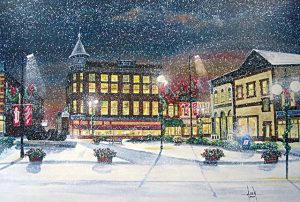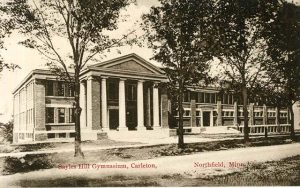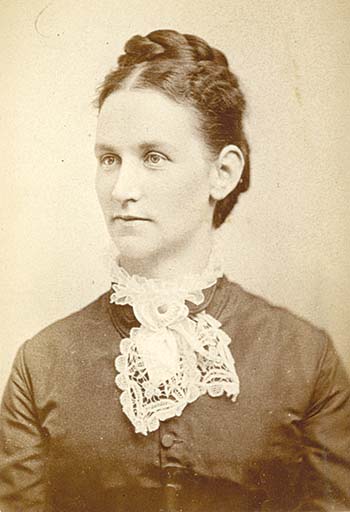
Margaret Evans served Carleton College from 1874 to 1908. A friend described her as being a “tall, slender, dark-eyed woman whose keen eyes seemed to see thru one’s barriers and read one’s very soul.” Photo by A.F. Burnham, Faribault artist and photographer, 1878. Courtesy Carleton College Archives.
“Married, Happy, Going to Honolulu.” This was the telegram that Margaret Evans, age 72, sent to her niece in Minneapolis following her unexpected marriage in Tacoma, Washington, on Nov. 7, 1914, to George Huntington, who had just turned 79.
The wedding of these two retired Carleton professors was revealed in the Minneapolis Journal and led to front-page headlines in both the Northfield Independent (“Notable Wedding Surprises Northfield”) and the Northfield News. Evans was a revered professor of English literature and women’s dean at Carleton College from 1874 to 1908. The Journal account said, “There is perhaps no better known Minnesota woman than the silver-haired bride. She has been president of the Minnesota Federation of Women’s clubs, chairman of the Minnesota state public library commission, president of the Women’s Board of Foreign Missions and a member of the Minnesota state art commission. She is vice president for life of the General Federation of Women’s clubs and is a speaker and writer of note on missionary and educational topics. Her reputation is country-wide.” About Huntington, professor of rhetoric and logic, the Journal wrote, “There are few Minnesota educators better known than the venerable bridegroom. He is the author of novels, books of history and criticism and a contributor to leading magazines.”
A late-in-life romance! How long would happily ever after last for the beloved couple whose union was so widely celebrated? Read on.
Daniel Morris Evans and Sarah James Evans had emigrated from Western Wales to New York in 1835. Margaret was born in Utica on Jan. 9, 1842, the sixth of their ten children. According to a history of the Welsh in Minnesota published in 1895, Daniel (a tailor) took his family westward to Winona, Minn., in 1855, helping to organize a Congregational Church there.
Barely in her teens, Margaret Evans applied to teach in a rural Winona County school. The board was said to be impressed with her test scores and “tall dignified presence” and hired her, though when they discovered she was then only 14 years old, she was asked not to tell anyone her age. (When a Northfield News reporter asked her in 1923 what her girlhood ambition had been, Evans replied, “To grow up.”)
The Evans family moved to a farm near St. Charles in 1858 and ended up in Faribault, where they attended the Plymouth Congregational Church. Daniel was active in starting and maintaining seven Sunday schools in the outlying areas. The 1895 Welsh history book said Daniel “taught the tailoring trade” for many years at the “Deaf and Dumb Institute” (as it was known then) in Faribault and died in December of 1878.
In 1865, Margaret Evans enrolled at Lawrence University in Appleton, Wis., because the study of Greek was available to women there. She majored in the classics, earning a B.A. in 1869. After earning an M.A. at Lawrence, she was hired in 1872 to work as instructor and preceptress, supervising women students there.
Meanwhile, the Rev. James W. Strong, president of Carleton College, had a problem. The young school (founded in 1866) needed a preceptress and, in the spring of 1874, he was determined to woo the capable Miss Evans away from her alma mater for the position in Northfield.
On April 25, 1874, Strong wrote her about the “delightful spirit of harmony and cooperation in the faculty” and spoke of Carleton’s growing importance and good reputation in the state, “both as to scholarship and religious influence.” On May 5, he stressed the opportunity she would have to mold the character of the young institution, told of the enrollment from five states and 26 Minnesota counties (two-thirds “regard themselves as Christian”) and assured her “God’s blessing attends this enterprise.” He concluded, “The work and its associations are in harmony with your aims and your religious preferences. It need not be temporary work. Minnesota is your home. This is your field in a sense in which Wisconsin cannot be. Are not all these strong reasons for your giving an affirmative response?”
Indeed they were, and when Evans was asked by the Northfield News (July 13, 1923) why she came to Northfield, she replied, “President Strong’s urgency. Proximity to family home at that time. Carleton’s record. Opportunity for Christian work.” Evans was a resident of Northfield from September of 1874 until the end of her life, devoting 34 years to Carleton. In 1889, she was given the title “Lady Principal” and took the name “Dean of the Women’s Department” in 1898.
Evans began her career at Carleton living with the women students in what had been known as the American House, a hotel built by town founder John North. This building had been converted into the college’s primary building until Willis Hall was constructed on campus in 1872.
In 1874, Carleton President James W. Strong offered Evans a position of “Preceptress” for $600 a year, including “board, room, lights and fuel.” Tuition averaged $8 per term. Willis Hall (pictured) was completed in 1872 and gutted by fire on Dec. 23, 1879. Courtesy Carleton College Archives.
In June of 1916, Evans was asked to tell about “things to be remembered” from her eight years at the “Old Hall” and 26 years (1882-1908) at Gridley Hall. She spoke of the lack of water and fire danger in the old building. And she recounted what happened there on Sept. 7, 1876. After the James-Younger Gang had tried to rob the First National Bank, the wife of one of the trustees and a matron ran to American House. The matron said, “Keep the girls off the street!” and fell down in a faint. Evans said, “We expected the robbers to come up and attack the college the next thing. I hastily prepared for them. Every girl was to take an axe and we went all of us to the third floor determined to make a good resistance.” The robbers avoided Carleton and fled south.
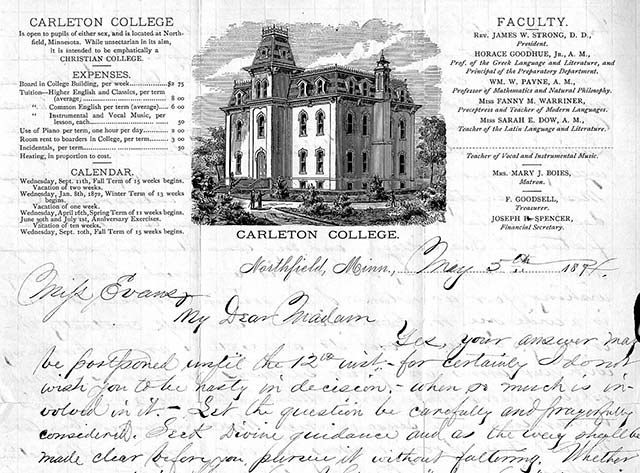
During December of 1882, there was much rejoicing when the women students moved into the long-awaited Gridley Hall. Carleton: The First Century by Leal A. Headley and Merrill E. Jarchow (1966) gives a vivid portrait of Evans in her domain: “Thrice daily, with stately tread, she swept down the 200 feet of hallway from her apartment to the Gridley dining room where she presided majestically over senior tables at which a sprinkling of intrepid male students joined the ladies for meals.” At one of the meals, Evans offered a prize to the “member of her table guessing the author of the largest number of quotations.” Also commemorated is “Miss Evans’ famous ‘two-foot rule,’ the distance which should always separate the sexes.” The book gave a remembrance from 1903 from a woman who participated in the frequent chats around Evans’ hearth: “There is a Genius in this room which makes a girl’s life seem nobler, more worth living; which gives higher ideals, and worthier purposes; which makes us dissatisfied with our narrowness and selfishness, and teaches us to look with a purer vision into broad fields where our influence may count for true womanhood. It is like a vision to us.”

Archives.
Northfield photographer Ira Sumner took the undated photo of Carleton’s Dean of Women Margaret Evans. At Gridley Hall, Dean Evans “presided majestically over senior tables at which a sprinkling of intrepid male students joined the ladies for meals. Around her hearth were frequent chats.” From Carleton: The First Century. Image courtesy Carleton College Archives.
Evans gave weekly lectures in Gridley’s chapel and was a popular speaker in Northfield and beyond. In class and out, she shared her wealth of knowledge acquired from studies at home and abroad, at a time when travel to other countries was unusual for women. She spent six months studying at Oxford and had many stays in France and Germany. The Faribault Republican of May 23, 1891, commented that her lecture before the Ladies’ Literary Society in Faribault on the French Revolution and English literature was “of high literary merit, and evidently the fruit of careful and exhaustive study and mature reflection.”
Evans’ reputation was such that she was invited to become the dean of prestigious Wellesley College in Massachusetts, with the potential to become president. But she said, “There are many who will accept a deanship at the new and rich Wellesley but not so many to stay by our young and poor western colleges. I am building my brain and heart into Carleton College and cannot desert her.”
Evans provided “town and gown” receptions at Gridley during the college year for all ages. For example: In October of 1895, she held a party at Gridley for 40 youngsters, ages 1-3 years, chaperoned by their mothers. And William Schilling wrote in the Northfield Independent of July 16, 1953, about monthly events Evans held where “men were expected to wear tails for the occasion” and “If the invited did not show up for two months with sufficient excuse in writing he was dropped from the society rolls of that function. Several of the business men of the town purposely did not attend, as they did not have or did not want to doll up for these occasions.”
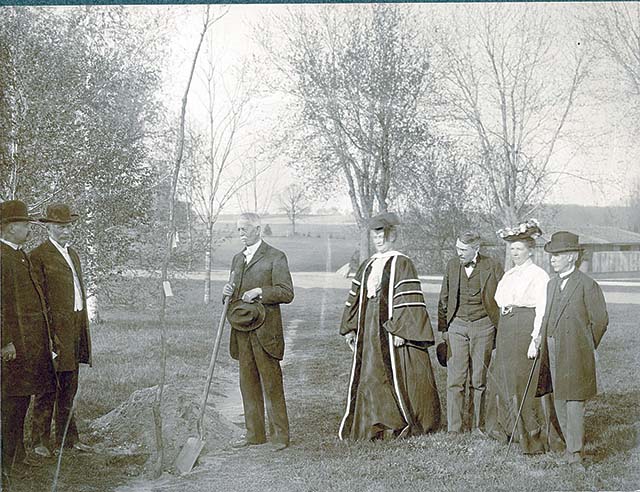
the planting of 24 white elms on campus after the inauguration of Carleton’s second president, William H. Sallmon (with shovel), on May 6, 1903. Courtesy Carleton College Archives.
In the fall of 1876, Evans had invited women of the community to meet in the old Ladies’ Hall to read, study and converse with her about art, literature and drama twice a month on Monday afternoons. Originally called the Reading Circle, the Monday Club was formally organized in 1894 and renamed the Margaret Evans Huntington Club in 1925. The club continues today (see accompanying story).
Among Evans’ greatest accomplishments was her involvement with the burgeoning women’s club movement, even beyond Northfield. The national General Federation of Women’s Clubs was formed in 1890 to help unite clubs to work together and when the Minnesota Federation was organized in Minneapolis in April of 1895, Evans was unanimously elected its first president and went on to become chairman of the educational department of the national group.
Evans encouraged women’s clubs to work with town improvement associations on beautification projects, as had been done in Northfield. But perhaps her most notable address was on “The Public Schools A Moral Factor in the Nation,” given at the General Federation of Women’s Clubs convention in Louisville, Kentucky, on May 28, 1896. She had sent out questionnaires to businessmen and principals of schools about their perceptions of honesty in their workplaces. In her speech, she quoted a grocer who had said, “I fear that 15 percent of honest men is a higher estimate than my experience warrants,” a percentage that got her a lot of publicity, locally and nationally.
Schilling, in his 1953 story about Evans, wrote, “The Twin City dailies gave her plenty of unwanted advertising on this, and quite naturally the Northfield merchants gave her plenty more. Undoubtedly, what she was getting at was that in shopping she always found the largest apples in the top of the barrel, etc.”
Evans’ marriage in 1914 to retired professor of rhetoric and logic George Huntington, along with their Hawaiian honeymoon, came as a surprise to almost everyone. Courtesy Carleton College Archives.
In actuality, Evans had not minced words. In her address, she said that the “average business man – not your friend or mine, of course – lies and cheats when it is sufficiently to his pecuniary advantage to do so.” She proclaimed, “The real battle for honesty in the business world, and for morality in every sphere, must be fought in the schools” and she concluded, “What greater work awaits this host of women than the uplifting of the public schools to still higher glory, as the gymnasium not only of mind and muscle, but also of morals?”
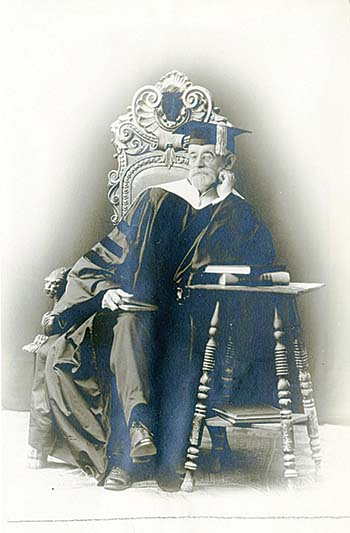
and logic George Huntington, along with their Hawaiian honeymoon, came as a surprise to almost everyone. Courtesy Carleton College Archives.
In October of 1896, Evans welcomed the president of the National Federation of Women’s Clubs to Gridley, with 125 Northfield club members present (the Northfield News of Oct. 17 said such interest “will make Northfield the banner town in the Northwest for organizations of this character”). The next year, Evans was in a whirlwind of activity: meeting in the Twin Cities with senators to urge passage of a bill to establish a State reformatory for women; addressing the American Missionary Association in Minneapolis; presiding over the 3rd annual meeting of the Minnesota Federation of Women’s Clubs in St. Paul (the original 17 charter member clubs had grown to 81); hosting a reception and joint session at Gridley Hall for the six federated women’s clubs of Northfield and the women’s clubs of Faribault, Owatonna and Farmington. In 1898, Evans was elected the first woman member of the American Board of Foreign Missions, in Grand Rapids, Michigan, and in 1899, she was the first woman member of the Northfield Board of Education.
After her retirement from Carleton in 1908, Evans traveled for a year to Spain, Italy and Egypt. (Characteristically, she gave a lecture course on Egypt at the Baptist Church in Owatonna upon her return.) The Pioneer Press of Jan. 15, 1910, reported that she is “reaping the reward of a long life spent for others in educational, missionary and philanthropic labor, and has now retired to a charming little home built for her near the campus at Northfield where she keeps open house for her many friends whose name is legion.”
In full academic gown, Dean Margaret Evans (whose interests extended to landscaping) attends the planting of 24 white elms on campus after the inauguration of Carleton’s second president, William H. Sallmon (with shovel), on May 6, 1903. Courtesy Carleton College Archives.
In August of 1914, Evans welcomed a suffragist committee from the Twin Cities at a luncheon at Northfield’s Congregational Church, put on by the women’s organizations of Northfield. A vocal soloist sang a suffrage song composed by George Huntington, to the tune of “Dixie.” Huntington was by now a widower, with his first wife Caroline having died on Jan. 1, 1912.
That fall, Evans went to visit at her brother William Evans’ home in Washington. It was there her surprise marriage to Huntington took place in November of 1914. Huntington wrote back to the Northfield News that they had rented rooms for the winter in Hawaii “overlooking the ocean and on a most beautiful drive.” He said that the natives shiver when the thermometer is in the 60s and added, “We enjoy it very much for a change and do not greatly miss sleighing and skating.”
Margaret Evans Hall, a residence for women, was named in 1923 and completed in 1927. It is still in use today for both sexes. Courtesy Carleton College Archives.
The couple returned to Northfield in April and Huntington died on Jan. 2, 1916, at the age of 80. That same year Margaret Evans Huntington was honored with an L.H.D. degree during celebrations of Carleton’s 50th anniversary and in 1923 it was announced that the new dormitory for women would be called Margaret Evans Hall. It was the first building on campus to be named after a staff member and was completed in 1927. She died on March 17, 1926, at her home on Winona Street at the age of 84.
Margaret Evans Huntington was asked by the Northfield News of July 13, 1923, “If you were counseling a young woman about to start out in life for herself, what would be your advice?”
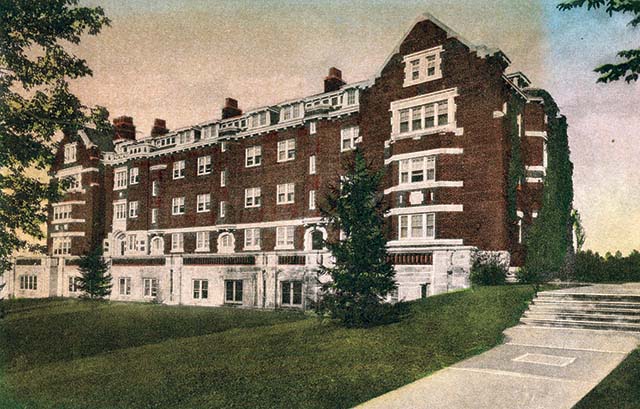
Her response was simply: “Choose the highest possible goal and never lower the aim.”
It is obvious she followed her own advice.
Thanks to Eric Hillemann at the Carleton College Archives, the Northfield Historical Society and the Northfield Public Library for access to information on Margaret Evans.
Margaret Evans Huntington Book Club Continues Today
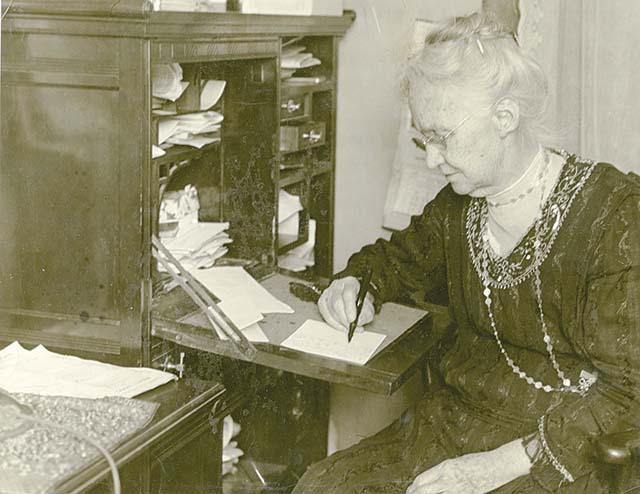
Margaret Evans founded a book club in 1876 and was president from 1894-1924 when it was called the Monday Club. This picture was taken at her home on Winona Street after she stepped down as president. The club was renamed for her in 1925 and continues today as the Margaret Evans Huntington Book Club. Courtesy Carleton College Archives.
Northfield is known for a certain bank raid in September of 1876, but this month and year is also when one of the state’s oldest book clubs was established. Margaret Evans of Carleton College invited a group of women to read and study art, literature and drama with her, first at a former hotel converted for the young college’s use and then in Evans’ new quarters at Gridley Hall. It was called the Reading Circle until 1894 when it was renamed the Monday Club for the day of its meetings.
The Monday Club was one of six women’s clubs in Northfield. One prominent gathering was held in December of 1897 at Gridley Hall with clubs from Northfield, Faribault, Owatonna and Farmington. Here the Monday Club reported that in past months they had been studying the dramas of Euripides and other Greek dramatists and Greek legends as an element in the literature of other nations. Evans presided in her role as president of the Minnesota Federation of Women’s Clubs.
Evans was president of the Monday Club from 1894 until 1924. The club honored her in 1925 by renaming itself the Margaret Evans Huntington Club, using her married name. The current club meets the first Monday afternoon of each month during the school year. The constitution limits active membership to 32. A committee chooses the topic for the year and this year’s theme is “The Marriage Plot.” Two members present their views of the chosen book before opening the meeting up for discussion.
Deane Barbour participated in an oral history for Carleton in 2003. A member of the club since 1957, she said she considered it a “pleasure and a privilege” to be part of this “college caliber” organization, with its emphasis on learning. It had given her a “deep respect for writing that is graceful, beautiful and really affects one’s view of life, of other cultures.” She said that the members “all grew up loving books,” and she commented on the wide range of yearly topics, including Africa, 19th century Russian novels, women in literature, Indians in North America, Jane Austen, satire and humor. She also recalled the 100th anniversary of the club in 1976 when members had a formal tea at Carleton’s Nutting House “wearing long skirts, fancy blouses and hats” of days gone by, as a tribute to the club’s founding.
Current club president Patricia Lewis values being a member because “It leads me to read things I wouldn’t necessarily read on my own.” She said the presentations and discussions help her to greatly appreciate what has been read.
Exactly what the club founder had in mind in 1876.


